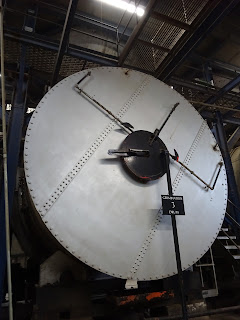As there's not much chance to visit places at the moment I made the most of it when business took me to French and Jupp's maltings as they were kind enough to give me a socially distanced tour. The company has been on the same site for over a century, though some of the buildings are now let out as offices and industrial units.
They have drum maltings where the whole drum rotates during germination to prevent the rootlets of the grains tangling. If I remember rightly they were built for 10 tonnes but they now fill them with 18 tonnes of barley, slightly larger than the ones I used to work with!
The green (i.e. unkilned) malt goes to roasting drums where gentle moist heat allows enzymes inside the grain to convert starch to sugar before the temperature is raised and moisture reduced to crystallise the sugar and make crystal malt and cara malts.
The roasting drum (a modified coffee roaster) below was used to make roasted malts though (e.g. amber, brown, black).
The temperature in a roasting drum can come close to combustion temperature (and even exceed it at times!) so colour development can be rapid and frequent sampling is required.
 |
| Grains cut in a farinator |
 |
| Chocolate malt |
The temperature has to be reduced by spraying on water before the desired colour is achieved as some colour development continues during cooling.
 |
| Old floor maltings |
This last picture was taken from a footbridge over the canal that barges full of brown malt used to start their journey to London on.







Fabulous - ashamed to say I've never been round a working Hertfordshire maltings, though I lived in the county for 28 years.
ReplyDeleteShame most of the text vanished though, I'll give it another go.
Delete